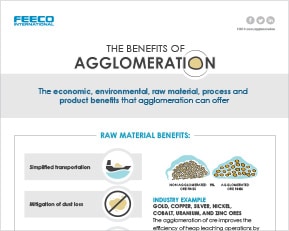Agglomeration refers to particle size enlargement. The choice to agglomerate material is common in a wide range of industries, from agriculture to mining and even specialty chemicals. The process offers a myriad of advantages, many of which are becoming more and more relevant in today’s global market as products become more specialized and producers look to tighten control over particle characteristics.
The benefits of material agglomeration include waste reductions, increased product efficiency, increased material functionality, improved product characteristics, and enhanced material handling — and the list goes on. This article outlines the basics of agglomeration, as well as the many reasons why a producer may choose to agglomerate their material.
What Does it Mean to Agglomerate Material?
Agglomeration, and specifically agitation agglomeration, is a process that encourages material fines to collect together, and then be refined via tumbling into a pellet or granule. This type of agglomeration is also commonly referred to as non-pressure agglomeration, pelletizing, tumble-growth agglomeration, or wet granulation.
Agitation agglomeration uses a tumbling motion and liquid binder to “grow” material into a rounded granule in a layering effect similar to rolling a snowball, known as coalescence.
A variety of elements are considered when determining which agglomeration equipment and process configuration should be used. Contributing factors include: equipment capabilities, binder properties, industry standards, desired product outcomes, and raw material characteristics.
Will My Material Agglomerate?
It’s important to note that not all materials respond readily to agitation agglomeration. FEECO recommends testing in the Innovation Center to evaluate the feasibility of an intended process with a representative sample of the source material, as well as to gather the process data necessary for scale-up.
Why Agglomerate: Benefits
When a material is agglomerated, you can expect to achieve several of the following benefits.
Click on the image to view our infographic on the benefits of agglomeration.
Product Benefits
Dust-free product handling, segregation prevention, and improved product characteristics and appearance.
Industry Example: Agglomerated agricultural wastes (such as manure or compost) are easier to transport, store, and apply than unprocessed fertilizers. Other improved characteristics include a more precise fertilizer formula that combats the risk of runoff pollution.
Raw Material Benefits
Simplified transportation, dust loss prevention, and increased porosity, density, and melting abilities.
Industry Example: Ore agglomeration creates a uniform particle size distribution, which in turn maximizes the heap leaching process, allowing a more efficient extraction of minerals from the ore.
Process Benefits
Elimination of dust and fines, increased process flow effectiveness, and increased process efficiency.
Industry Example: Glass powder in its raw state incurs a great deal of material loss during processing. Agglomerated glass powder reduces product losses and increases process efficiency.
Economic Benefits
Conversion of waste to a marketable product, reduced transportation costs, and reduced material handling costs.
Industry Example: After agglomeration, previously unsalable limestone fines become a marketable product (limestone soil amendment pellets).
Environmental Benefits
Potential to eliminate the need for landfill, improved cost-efficient recycling capabilities, potential for waste-to-fuel processes, and improved waste disposal cost efficiency.
Industry Example: After agglomeration, previously landfilled waste paper sludge is recycled into a usable product.
In addition to the benefits listed above, the following chart identifies specific reasons why agglomeration is used in various applications:
| Reason | Typical Application |
| To produce useful structural forms | Powder metallurgy |
| To provide a defined quantity for dispensing and metering | Agricultural chemical granules, pharmaceutical tablets |
| To eliminate dust handling hazards or losses | Briquetting of waste fines |
| To improve product appearance | Food products |
| To reduce caking and lump formation | Fertilizers |
| To improve flow properties for further processing | Pharmaceuticals, ceramics |
| To increase bulk density for storage | Detergents |
| To control dispersion and solubility | Instant food products |
| To control porosity and surface-to-volume ratio | Catalyst supports |
| To improve permeability for further processing | Ore smelting |
| To create non-segregating blends of powder ingredients | Ore smelting, agricultural chemicals, pharmaceuticals |
Source: Lister, Jim and Ennis, Bryan. The Science and Engineering of Granulation Processes. Boston : Kluwer Academic Publishers, 2004.
Choosing to Agglomerate With FEECO
Since 1951, FEECO has been delivering custom agglomeration equipment and complete systems to a diverse range of industries. Our strength in the field of agglomeration lies in our decades of experience and our total system capability. “What sets us apart in terms of agglomeration solutions is our Innovation Center, which help us determine the best possible process to suit a customer’s needs,” states Chris Kozicki, FEECO Sales Engineer. “Our wide range of experience across industries is applied and adapted to benefit a customer’s unique needs.” Utilizing versatility and vast processing knowledge, FEECO can not only determine if a material is suitable for agglomeration, but also what equipment is needed to deliver optimum results from the final product. The possibilities with agglomeration are endless, with more and more innovative solutions being developed each year. From reducing waste, to generating new income streams, the benefits of agglomeration processing are a proven technology for managing material problems and creating beneficial reuse opportunities. To discuss how agglomeration may benefit you, or for more information on FEECO’s agglomeration equipment, testing services, or parts and service support, contact us today!



